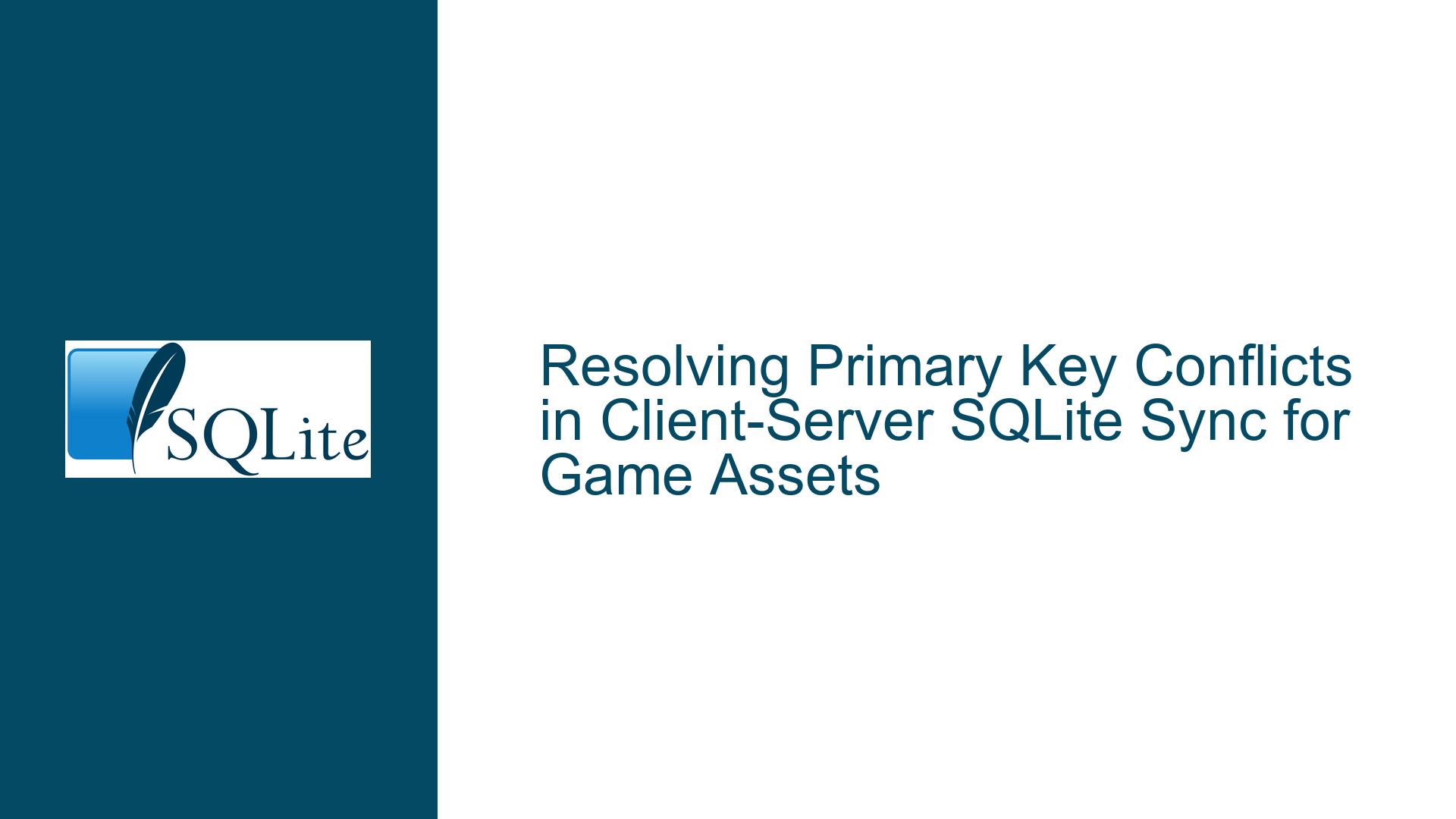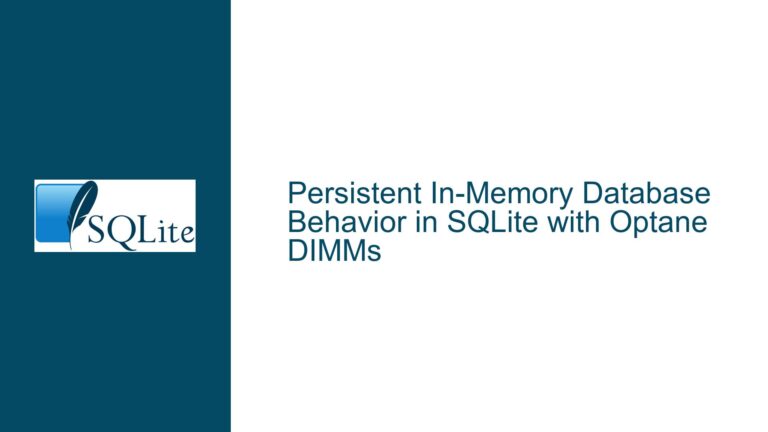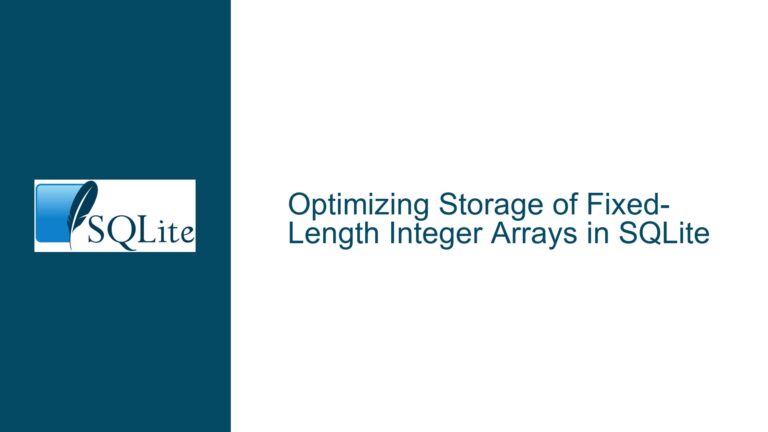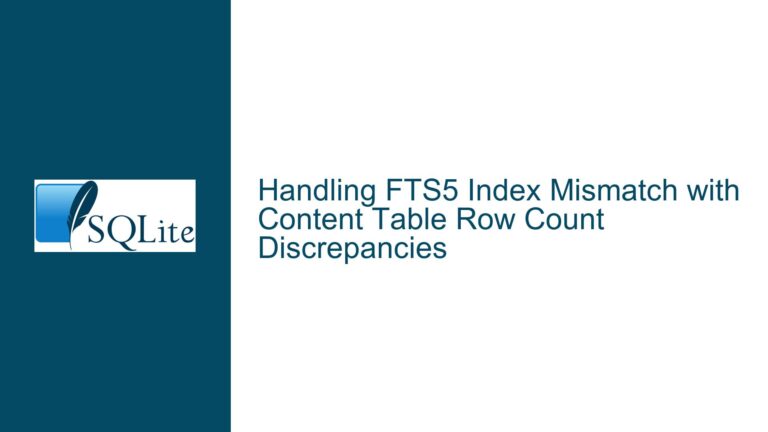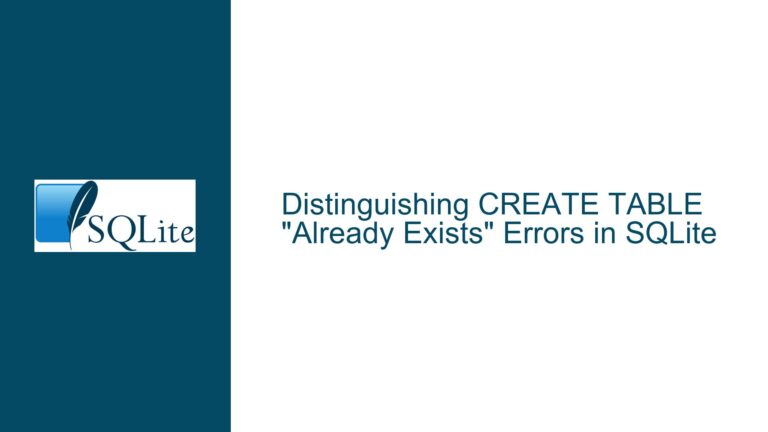Resolving Primary Key Conflicts in Client-Server SQLite Sync for Game Assets
Primary Key Strategy for Cross-Environment SQLite Synchronization
Understanding the Dual-Role SQLite Schema for Game Asset Management
The core challenge revolves around designing a SQLite schema that functions reliably in two distinct environments: a server database (acting as the authoritative source of truth for game assets like maps and skins) and a client database (serving as a local cache for downloaded assets). Both environments must agree on a unique identifier system to ensure that references to assets (e.g., map_id 123) are consistent and unambiguous. The original schema proposes a dual-ID structure:
CREATE TABLE maps(
uid INT PRIMARY KEY, -- Server: authoritative ID; Client: unused dummy
id INT -- Client: mirrored server ID; Server: unused dummy
);
This approach introduces redundancy and potential synchronization pitfalls. The server’s uid is the authoritative identifier, while the client’s id mirrors this value. However, this design complicates maintenance, synchronization, and query logic. Key questions arise:
- Why use separate columns for server/client IDs?
- Is
AUTOINCREMENTnecessary for generating authoritative IDs? - How do ordering and uniqueness constraints affect synchronization?
The confusion stems from conflating the roles of primary keys and application-level identifiers, misunderstanding SQLite’s ROWID mechanics, and overcomplicating synchronization workflows. Below, we dissect these issues systematically.
Root Causes of Redundant ID Columns and Sync Complexity
1. Misunderstanding SQLite’s Primary Key Semantics
SQLite treats INTEGER PRIMARY KEY columns as aliases for the implicit ROWID column, which is a 64-bit signed integer that auto-increments by default (without requiring the AUTOINCREMENT keyword). If a table lacks an INTEGER PRIMARY KEY, SQLite creates a hidden ROWID column. Critically:
- Uniqueness: The
ROWID(or its alias) guarantees uniqueness within the table. - Ordering: The
ROWIDis assigned in ascending order unless explicitly overridden byINSERTstatements.
The original schema uses uid INT PRIMARY KEY, which does not alias ROWID because INT is not equivalent to INTEGER in SQLite. This forces manual management of uid values, defeating the purpose of leveraging SQLite’s built-in auto-increment behavior.
2. Overengineering Client-Server ID Mapping
Maintaining separate uid (server) and id (client) columns assumes that the client and server databases operate in isolation. However, this creates synchronization overhead:
- Server: Must generate
uidand ensure it is propagated to clients. - Client: Must store the server’s
uidin itsidcolumn while maintaining a localuid(which serves no practical purpose).
This redundancy violates normalization principles and introduces opportunities for desynchronization (e.g., if a client accidentally modifies id or uid).
3. Confusion Between AUTOINCREMENT and Default ROWID Behavior
The AUTOINCREMENT keyword enforces that SQLite will never reuse ROWID values, even if rows are deleted. Without AUTOINCREMENT, SQLite may reuse ROWID values after deletions, which is more efficient. For most use cases, AUTOINCREMENT is unnecessary unless strict monotonicity (no gaps) is required.
The user’s concern about clients encountering maps in arbitrary order (e.g., map 4, 1, 3, 8) conflates primary key ordering with application-level sequencing. Primary keys need only be unique; ordering is an application concern, often managed via timestamps or version numbers.
4. Inadequate Asset Synchronization Strategy
The proposed schema lacks a clear mechanism for clients to fetch and reconcile server-generated IDs. For example:
- How are clients notified of new/updated maps?
- How are conflicts resolved if a client modifies a local asset?
- What happens if the client operates offline and generates its own IDs?
Without addressing these questions, the dual-ID approach becomes a liability.
Streamlining Schema Design and Synchronization Workflows
1. Unified Primary Key Strategy
Problem: Redundant uid and id columns complicate synchronization.
Solution: Use a single INTEGER PRIMARY KEY column aliasing ROWID on the server, propagated to clients.
Revised Schema:
CREATE TABLE maps(
map_id INTEGER PRIMARY KEY, -- Server: authoritative; Client: mirrored
name TEXT NOT NULL, -- Human-readable identifier (e.g., "forest_map")
hash BLOB NOT NULL, -- Checksum for versioning
data BLOB -- Serialized map data
);
Server Workflow:
- Insert new maps without specifying
map_id:INSERT INTO maps (name, hash, data) VALUES ('forest_map', X'...', X'...');SQLite auto-generates
map_idas the nextROWID. - Clients fetch
map_idalongside asset data (e.g., via API response).
Client Workflow:
- Store downloaded maps using the server’s
map_id:INSERT OR REPLACE INTO maps (map_id, name, hash, data) VALUES (123, 'forest_map', X'...', X'...'); - Use
map_idin-game to reference assets (e.g., loadmap_id=123).
Benefits:
- Eliminates redundant columns.
- Guarantees ID consistency between server and client.
- Leverages SQLite’s efficient
ROWIDmanagement.
2. Avoiding AUTOINCREMENT Unless Necessary
Problem: Unnecessary use of AUTOINCREMENT incurs overhead.
Solution: Omit AUTOINCREMENT unless strict monotonicity is required.
When to Use AUTOINCREMENT:
- If the server must ensure that
map_idvalues always increase and are never reused (e.g., for audit trails). - If clients cache historical data and rely on gaps to detect deletions.
Revised Schema with AUTOINCREMENT:
CREATE TABLE maps(
map_id INTEGER PRIMARY KEY AUTOINCREMENT,
...
);
Performance Considerations:
- Without
AUTOINCREMENT, SQLite uses thesqlite_sequencetable to track the maximumROWID, but reuse is possible. - With
AUTOINCREMENT, SQLite adds overhead to prevent reuse, which is rarely justified for game asset management.
3. Client-Server Synchronization Protocol
Problem: Arbitrary client access order (e.g., map 4, 1, 3, 8) does not affect primary key validity.
Solution: Implement synchronization via incremental updates and conflict resolution.
Server API Endpoints:
GET /maps/changes?last_sync=<timestamp>: Returns new/updated maps sincelast_sync.- Response format:
{ "changes": [ { "map_id": 123, "name": "forest_map", "hash": "a1b2c3", "data": "base64_encoded_bytes", "deleted": false, "timestamp": 1729123456 } ] }
Client Synchronization Logic:
- Store
last_synctimestamp locally. - Periodically poll
/maps/changesto fetch updates. - For each change:
- If
deleted:DELETE FROM maps WHERE map_id = ?. - Else:
INSERT OR REPLACE INTO maps ....
- If
Conflict Resolution:
- Use
hash(e.g., SHA-256) to detect data corruption or unauthorized client modifications. - If a client-modified asset conflicts with the server’s version, prioritize the server’s authority.
4. Handling Offline Clients and Local Modifications
Problem: Clients may generate local assets when offline.
Solution: Use negative map_id values for client-local assets.
Schema Adjustment:
CREATE TABLE maps(
map_id INTEGER PRIMARY KEY, -- Positive: server-authoritative; Negative: client-local
...
);
Workflow:
- Client generates a local map:
INSERT INTO maps (map_id, name, hash, data) VALUES (-1, 'client_map', X'...', X'...'); - Upon reconnecting, client uploads local maps to the server:
POST /maps/upload { name: "client_map", hash: "...", data: "..." } - Server assigns a positive
map_idand returns it:{ "temp_id": -1, "server_id": 124 } - Client updates local references:
UPDATE maps SET map_id = 124 WHERE map_id = -1;
Benefits:
- Prevents conflicts between server and client-generated IDs.
- Simplifies reconciliation after offline periods.
5. Migrating from the Legacy Schema
Problem: Transitioning from dual uid/id columns to a single map_id.
Migration Steps:
Server Database:
- Rename
uidtomap_id:ALTER TABLE maps RENAME COLUMN uid TO map_id; - Drop the redundant
idcolumn:ALTER TABLE maps DROP COLUMN id;
Client Database:
- Add
map_idcolumn:ALTER TABLE maps ADD COLUMN map_id INTEGER; - Copy
idvalues tomap_id:UPDATE maps SET map_id = id; - Drop the
idanduidcolumns:ALTER TABLE maps DROP COLUMN id; ALTER TABLE maps DROP COLUMN uid; - Recreate
map_idasINTEGER PRIMARY KEY:-- SQLite does not support altering column types; use a temporary table. BEGIN TRANSACTION; ALTER TABLE maps RENAME TO maps_old; CREATE TABLE maps( map_id INTEGER PRIMARY KEY, name TEXT NOT NULL, hash BLOB NOT NULL, data BLOB ); INSERT INTO maps (map_id, name, hash, data) SELECT map_id, name, hash, data FROM maps_old; DROP TABLE maps_old; COMMIT;
Post-Migration Verification:
- Ensure all client
map_idvalues match the server’s authoritative IDs. - Test synchronization workflows with edge cases (e.g., conflicts, offline mode).
Key Takeaways and Best Practices
- Leverage
INTEGER PRIMARY KEY: Use it to aliasROWIDfor efficient, auto-incremented IDs. - Avoid Redundant Columns: A single authoritative ID column simplifies synchronization.
- Sync via Timestamped Changes: Use incremental updates to minimize data transfer.
- Handle Offline Scenarios Gracefully: Reserve negative IDs for client-local assets.
- Prefer Simplicity Over
AUTOINCREMENT: Unless strict ID monotonicity is required.
By unifying the schema and adopting a robust synchronization protocol, you eliminate redundancy, reduce maintenance overhead, and ensure consistent asset references across server and client environments.
